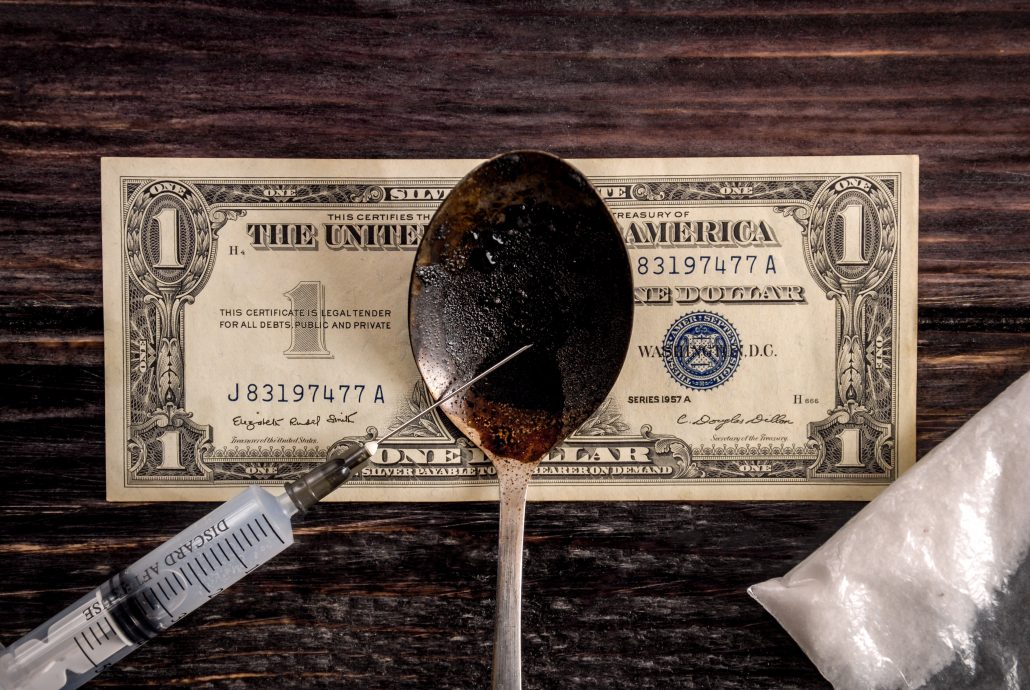by Justin Mckibben | Aug 28, 2018 | Addiction Treatment, Detox, Drug Abuse, Drug Policy, Heroin, Law Enforcement, Opioids, War on Drugs

When we talk about the opioid epidemic in America, we talk a lot about the cost of human life. Over the last few years, the outbreak of heroin use has continued to rise. This kind of inflation has come at the price of tens of thousands of lives each year lost. 2017 is already considered the worst year for overdose deaths in American history. There is no way we could possibly put a value on the lives of those lost. We can’t give a consultation on the damage their deaths have done to families and communities across the country. But looking at how heroin and opioids have hurt the economy gives us another means to measure the true cost of the opioid crisis.
We already know we’ve gone well over budget with the failed War on Drugs. While dollar amounts will never compare to the devastation of losing loved ones, maybe it can add another layer of perspective to the issue. So, how has heroin addiction hurt the economy?
How Heroin Hurts the Economy
It is actually complicated trying to identify exactly how heroin addiction hurts the economy. There are a lot of unique elements to take into account. For example, many have suspected that even the incredibly high rates of overdose death recorded may actually be under-reported and misclassified.
One study from a few years ago highlights several big-picture ways heroin addiction hurts our economy. This study assesses three “invisible costs” of heroin addiction most people don’t recognize.
-
Medical Costs
We will start with the one that seems pretty obvious. Although, the cumulative effect of heroin addiction on the medical treatment infrastructure is more complex than you might expect.
Utilizing data from the mid-90s, the study estimates that heroin addiction treatment amounted to $5 billion dollars. That was so long ago, it is incredibly easy to predict that tab has shot up drastically in the last decade and a half as heroin use has consistently skyrocketed.
Another thing most people don’t realize is that the types of addiction treatment people have access to will depend on what their insurance will pay for. Because insurance companies are often more interested in keeping costs down than effectively treating addiction, it is safe to bet that a lot of that humble estimation of $5 billion was probably wasted on lackluster facilities and regimens that did not offer innovative and effective treatment. Part of curbing these costs is about support programs that do offer quality care, including comprehensive residential treatment.
According to health research and consulting institute Altarum, healthcare costs alone related to the opioid crisis reached $217.5 billion between 2001 and 2017.
-
Loss of Productivity
Putting a value on something you don’t have is pretty difficult to do. It is hard to adequately propose a price tag for an amount of productivity you can’t measure, but in order to truly grasp how heroin addiction hurts the economy, you cannot ignore the loss of productivity.
One estimate from researches says that the economy missed out on $11.5 billion because of people either:
- Unable to work
- Diverting labor towards addressing heroin addiction
But this is just from a guess of labor costs. It is impossible to quantify all the potential that never becomes realized due to heroin and opioid overdose death. Many people who use drugs and actually do recover end up contributing so much to their communities. So one can hardly imagine what it would mean if the over 72,000 people who died in 2017 from drug overdose were still alive today and what difference they would be able to make.
-
Criminal Activity
On one hand, the United States criminal justice system does provide jobs to millions of Americans. However, the public typically funds these systems. Therefore, the taxpayer is the one paying to put people with heroin addiction through the criminal justice system.
Researchers estimate that criminal activity, adjudication, and incarceration in connection to heroin costs the economy approximately $5.2 billion. Luckily, there is a new trend across the country of police helping addicts get treatment through PAARI programs.
It All Adds Up
When we add up the estimates from the three categories the bill comes out to a staggering $21.7 billion dollars. But things have continued to get worse since that study was published. Another analysis from earlier this year estimates that the opioid crisis cost the country $115 billion in 2017. The organization also claims the economic toll of the opioid crisis between 2001 and 2017 is over $1 trillion.
The economic fallout of heroin and opioids is on track to be over $500 billion from 2018 to 2020!
According to Altarum, the greatest impact on the economy as a result of heroin addiction is the loss of earnings and productivity. Based on the average age of overdose victims, around 41 years old, that cost is estimated at about $800,000 per person.
When we look at all those billions and trillions, it is easy to see how heroin addiction hurts the economy. It all adds up to a truly tragic reality we face as a nation. However, the opportunity to put some of this money toward other endeavors should be a huge financial incentive that our leaders to make some much-needed changes. It’s just one more reason we should be taking meaningful actions to prevent heroin addiction and provide safe and effective heroin detox and holistic treatment options.
In the end, no amount of money can replace those who lose their lives to addiction. We can look at how these tragedies translate to transactions, but nothing is more valuable than helping those who suffer find the path toward a better future. True happiness and lasting recovery are absolutely priceless.
Palm Healthcare Company believes in providing innovative and effective addiction treatment for anyone battling with addiction. Our professional team of certified specialists offers comprehensive care, and our missing is to heal each individual’s mind, body, and spirit. If you or someone you love is struggling with substance abuse or addiction, please call toll-free now. We want to help.
CALL NOW 1-888-922-5398
by staff | Aug 16, 2018 | Family, Mental Health, Recovery, Relationships, Self Improvement, Sobriety

(This content is being used for illustrative purposes only; any person depicted in the content is a model)
By: Thomas G. Beley, PhD, LCSW
There is a German fable that states that relationships are like two porcupines trying to keep warm in the dead of winter. Move in too close, or too quickly, in the anticipation of feeling the warmth, chances are the porcupines are going to experience some discomfort and pain from their respective ill-positioned quills. Yet, being afraid of getting too close to each other, the porcupines are likely to run the risk of dying from the winter cold.
As individuals, our relationships are not too different than the porcupines. Whether it is with family, friends, co-workers or strangers, we are constantly in a natural process of trying to determine just how close we need to be with someone while at the same time not sacrificing our own individual beliefs, values, or needs. It is the negotiation of these two natural forces of individuality and togetherness that determines the success of any relationship. Too much of either or an imbalance can have unsettling effects.
It is important to understand that individuals are subject to an inherent process of trying to reach a successful balance between these two natural forces. Research has shown that this is a process rooted in nature and all living organisms. Being a part of all life means we have the desire to be our own person yet at the same time desire the safety and security of the group.
Finding Balanced Relationships
In humans, this process happens both consciously and unconsciously. We seek out relationships that will give us both the opportunity to pursue our own individual needs while at the same time involve ourselves in a relationship that is nurturing and comforting. Our behavior, whether good, bad, or indifferent, is often influenced by these forces of nature of trying to find that right balance between one’s need for individuality and togetherness. The successful balance of these two life forces is what brings us a sense of well being and contentment. It is our ability to maintain this delicate balance between individuality and togetherness that determines the quality of any given relationship.
It is also important to note, here, that the quest for individuality or togetherness is not to say that one is more important than the other. They are both extremely critical. However, it is how a person balances these two forces within their life and the relationship systems in place that makes the difference between staying calm and collected and being in a state of turmoil and conflict.
Relationship conflicts often occur when there is an imbalance in these two natural forces. Imbalances can occur both within the individual and within the relationship system itself. A common scenario that often develops is when one person within the relationship system desires more individuality and the other person in the relationship system desires more togetherness and closeness. As is often the case, one person begins to feel overwhelmed in the relationship while the other person may feel neglected. Typically, the person desiring more individuality is running away from the relationship system while the person seeking more closeness is chasing the relationship system.
The Dance of Conflict
This “dance” can occur in a variety of ways. One such way is when an individual requires an excessive amount of one or the other. Too much of an individuality influence may make it difficult for that person to make a meaningful connection with others, particularly those who desire more closeness and togetherness. In that desire to achieve a sense of individuality, a person can easily cut him or herself off from others. Along the same lines, a person with a high degree of individuality may find others having a difficult time making a meaningful connection with him or her. The same holds true for the person needing a great deal of togetherness. The desire to achieve closeness can result in the person becoming excessively dependent on others or not maximizing their own individual potential.
Another common scenario that is when one person desires individuality and the other person is requiring a sense of togetherness. A person who requires a sense of individuality will likely create a conflict in the relationship system of the person who has the desire to achieve more togetherness. The same dilemma holds true if two people have inordinate amounts of the same needs. Two people desiring a great deal of individuality will likely experience the cold of winter. Two people desiring a great deal of togetherness will likely feel the quills of another person. When there is an imbalance of these needs, anxiety occurs and the potential for conflict exists.
Find What Matters
It is important to emphasize that there is no magic formula that constitutes what is the right amount of togetherness or individuality within a relationship system. What truly matters is how a person manages their respective needs and the awareness of the needs of the other within the relationship system.
Doctor Thomas G. Beley, Ph.D., LCSW is the Executive Director of Palm Healthcare Company. For over 25 years, Doctor Beley has worked in the field of substance use disorder and mental health disorders. Through the years of helping people who struggle with drugs, alcohol and mental health issues, Doctor Beley has proven to be an expert clinician and an innovative and compassionate leader in the treatment industry. Palm Healthcare Company is grateful to have an executive team with experience and incredible commitment to helping others. If you or someone you love is struggling, please call toll-free now. We want to help.
CALL NOW 1-888-922-5398



